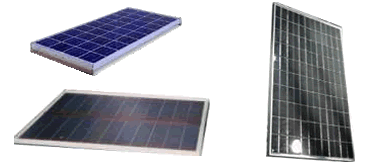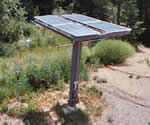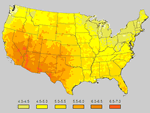|
| Solar Panels : An eco-friendly electric generator. |
|
Solar panels generate free power from the sun by converting sunlight to electricity with no moving parts, zero emissions, and no maintenance. The solar panel, the first component of a electric solar energy system, is a collection of individual silicon cells that generate electricity from sunlight. The photons (light particles) produce an electrical current as they strike the surface of the thin silicon wafers. A single solar cell produces only about 1/2 (.5) of a volt. However, a typical 12 volt panel about 25 inches by 54 inches will contain 36 cells wired in series to produce about 17 volts peak output. If the solar panel can be configured for 24 volt output, there will be 72 cells so the two 12 volt groups of 36 each can be wired in series, usually with a jumper, allowing the solar panel to output 24 volts. When under load (charging batteries for example), this voltage drops to 12 to 14 volts (for a 12 volt configuration) resulting in 75 to 100 watts for a panel of this size. |
|
Multiple solar panels can be wired in parallel to increase current capacity (more power) and wired in series to increase voltage for 24, 48, or even higher voltage systems. The advantage of using a higher voltage output at the solar panels is that smaller wire sizes can be used to transfer the electric power from the solar panel array to the charge controller & batteries. Since copper has gone up considerably in the last few years, purchasing large copper wiring and cables is quite expensive. (that's why pennies are made of mostly zinc today). |
|
 |
| The 3 basic types of Solar Panels |
|
Monocrystalline solar panels : The most efficient and expensive solar panels are made with Monocrystalline cells. These solar cells use very pure silicon and involve a complicated crystal growth process. Long silicon rods are produced which are cut into slices of .2 to .4 mm thick discs or wafers which are then processed into individual cells that are wired together in the solar panel. |
|
Polycrystalline solar panels : Often called Multi-crystalline, solar panels made with Polycrystalline cells are a little less expensive & slightly less efficient than Monocrystalline cells because the cells are not grown in single crystals but in a large block of many crystals. This is what gives them that striking shattered glass appearance. Like Monocrystalline cells, they are also then sliced into wafers to produce the individual cells that make up the solar panel. |
|
Amorphous solar panels : These are not really crystals, but a thin layer of silicon deposited on a base material such as metal or glass to create the solar panel. These Amorphous solar panels are much cheaper, but their energy efficiency is also much less so more square footage is required to produce the same amount of power as the Monocrystalline or Polycrystalline type of solar panel. Amorphous solar panels can even be made into long sheets of roofing material to cover large areas of a south facing roof surface. |
|
| Shading & Shadows on solar panels |
|
When deciding on a location for your solar panels, make sure no shadows will fall on the solar panel array during peak sunlight hours (say, 9am to 4pm). Not only will shading of the solar panels significantly reduce their output, but also could cause damage. Some solar panel manufacturers advertise panels that can withstand shading but they use internal diodes which in themselves reduce the power somewhat. I recommend simply choosing a good location to start with, even if it means cutting down a few trees or otherwise removing obstacles.
|
|
| Temperature & Wind loading considerations |
|
As previously discussed, you want to mount solar panels in a sunny and non-shaded location to get maximum sun. But, heat build-up is also a problem. Because the efficiency of solar panels decreases as temperature increases, the solar panel mounting system should allow for spacing around the individual solar panels for air circulation. The idea is to allow air cooling in the hot sun to reduce the temperature of the solar panels. Another consideration is wind loading. By allowing air to flow around the solar panels, not only will they remain cooler, but also the wind resistance of the entire array is less.
|
|
| Types of Solar Panel Array Mountings : Fixed, Adjustable, & Tracking |
|
Fixed solar panel mounts : If you use the most simple and least expensive type of solar panel mounting system, it will be completely stationary. The solar panels should always face the equator. (due south in the northern hemisphere). Don't forget that true south varies from magnetic south. This can make a huge difference. For example, true south in eastern Washington state is 161 on a compass instead of 180. The angle of inclination (tilt) in degrees should be set to about your latitude. Slightly more than your latitude will favor the winter sun and slightly less will favor the summer sun. (for a seasonal cabin for example). |
 |
|
|
Adjustable solar panel mounts : The angle of inclination (tilt) of an adjustable solar panel mount can be changed 2 or more times during the year to account for the lower angle of the sun in winter as the earth orbits the sun causing seasonal change. A good rule of thumb is latitude + 15 degrees in the winter and latitude - 15 degrees in the summer. This will increase overall solar panel output by approximately 25%. I adjust my solar panel array 4 times per year. (Shown here in its summer position). An easy approach that works pretty good is to set the tilt for the winter position in about mid October and back to summer position in mid March. |
 |
|
|
Tracking solar panel mounts : Tracking solar panel mounts follow the path of the sun during the day to maximize the solar radiation that the solar panels receive. A single axis tracker tracks the sun east to west and a two-axis tracker tracks the daily east to west movement of the sun and the seasonal declination movement of the sun. |
|
I must admit that a tracking type of solar panel mount is the most efficient type. However, when I investigated the cost for these mounting systems, I found that for the 20 to 30 percent gain in output they provided I could buy 25% more panels cheaper and have the same increase in power with no mechanical failures to worry about. Also, you'll get far less extra gain in winter assuming it doesn't freeze up! |
|
Therefore, I recommend that instead of 6 panels on a tracking mount that costs $2000-$3000, just spend $700-$800 on 2 more solar panels and gain a year round increase of 25 to 30%. Simple math, huh? |
|
| How much sunshine will I need? |
|
For more detailed information on how many solar panels you will need based on the amount of sunshine available daily in your area (of the United States) please check out the advanced tutorial Solar Radiation. This will give you a better idea of how many solar panels you will need for your solar power system. |
 |
|
| Cost and expected LifeSpan of solar panels |
|
At today's prices a single solar panel, rated at 75-85 watts sells for about $375-$425 depending on brand. I have found that the brand does not seem to be a huge factor. If your system uses several of these panels, this would seem to be quite expensive. The good news is that today's solar panels have a life expectancy of 25 to 30 years or more. And just think, they'll be making FREE electricity that whole time!
|
|
| Summary |
|---|
| At today's prices, a typical 100 watt solar panel will cost about $400 to $500 or about $4 to $5 per watt. With a total of only six 80 Watt solar panels this Solar Home runs a refrigerator, computer, 27 inch color tv, microwave, various lights, misc devices, and even an Air Conditioner in the summer. Only for about 2 to 3 months in the winter (at 45 degrees north) is a generator used for 45 to 60 minutes per day to bulk charge the batteries. Since some winter days are sunny, the generator is not used every day. |
 |
|
|
| Design your system quickly with our Interactive Design Tools |
|---|
| (Note : These design tools require javascript to be turned on in your browser) |
|
* Check out our easy point & click System Sizing Estimator to quickly & easily calculate the number of solar panels and storage batteries you'll need for a wide range of system sizes.
|
|
* Our Battery Bank Design Tool will take the confusion out of wiring up your battery bank. Use 2, 4, 6, or 12 volt batteries to build a system voltage of 12, 24, or 48 volts using series and parallel wiring with just 4 clicks. Battery bank capacities from 300 AmpHours to over 4000 AmpHours are displayed graphically so you can see exactly how to wire the batteries together.
|
|
* This Wire Size Calculator will allow you to quickly find the correct wire size in AWG (American Wire Gauge) based on the distance to your solar panel array & the amount of amperage your panels put out. No math required!
|
|
|
New Feature! Check out our new feature Solar Projects where you can build easy, do-it-yourself projects for your solar power system to save money and have fun doing it!
|
|
|
|
|
|
|






